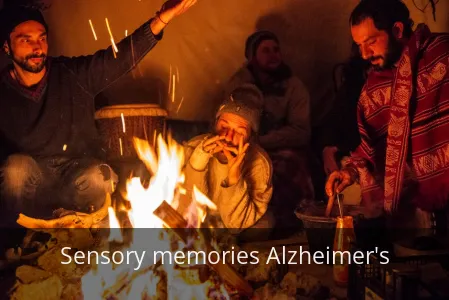
The Unbreakable Connection

Imagine a disease that can erase a lifetime of cherished memories, yet somehow leaves behind the scent of a loved one’s perfume or the melody of a first dance completely intact.
This isn’t a plot from a science fiction novel; it’s the surprising and profoundly hopeful reality for many individuals navigating the difficult journey of Alzheimer’s disease.
While this condition is most famously known for stealing names, dates, and faces, researchers have discovered a remarkable exception to the rule.
There is a category of memory that demonstrates an almost defiant resilience, clinging on long after other recollections have faded.
In this article, we will pull back the curtain on this incredible phenomenon.
You will discover why sensory memories—those tied to smell, sound, and music—often become the last, enduring connection to a person’s identity and past.
We will explore the fascinating science that explains this persistence and share touching, real-world examples that illuminate a beautiful silver lining in the face of a challenging diagnosis.
The Brain’s Fortress: Why Sensory Memories Endure

To understand why some memories survive the onslaught of Alzheimer’s, we first need a quick primer on how memory works—and how the disease attacks it.
Alzheimer’s disease typically begins its destructive path in the hippocampus, a seahorse-shaped region deep within the brain that acts as the central switchboard for forming new episodic and factual memories.
This is why forgetting recent conversations or struggling to recall a child’s name are often the first heartbreaking signs.
But what about the smell of rain on hot pavement or the opening chords of a beloved song?
These sensory memories are processed and stored differently, in areas of the brain that are affected much later in the disease’s progression, if at all.
Think of it like a library where a flood is slowly rising.
The new acquisitions desk and the biography section on the ground floor (the hippocampus) are the first to be damaged.
But the archives containing poetry, music, and the records of primal sensations are kept in a fortified tower on a higher floor, safe from the initial deluge.
This ‘fortress’ includes regions like the amygdala, which processes emotions, and the olfactory bulb, which is directly linked to our sense of smell.
Because these areas have a more direct connection to our emotional core and are more deeply embedded in the brain’s primal architecture, the memories they hold are far more durable.
The Power of a Song: When Music Unlocks the Soul

Perhaps the most well-documented example of this resilience is the profound connection to music.
You may have seen the viral videos: an elderly individual with advanced Alzheimer’s, seemingly lost to the world, who suddenly lights up and sings every word to a song from their youth.
This isn’t just a party trick; it’s a window into a preserved part of their consciousness.
The documentary Alive Inside beautifully chronicles this phenomenon, showing how personalized music playlists can reawaken individuals, sparking moments of clarity, conversation, and joy that families feared were gone forever.
Why is music so powerful?
Musical memory is one of the brain’s most widespread and robust functions.
Recognizing a melody involves a complex network that includes the auditory cortex, the frontal lobes, and, crucially, the cerebellum and amygdala.
This distributed network means that even if one pathway is damaged, others can often pick up the slack.
Furthermore, the music we love from our adolescence and young adulthood is often emotionally charged, tying it directly to our sense of self and our strongest feelings.
It’s as if the brain treats these musical memories not as mere facts, but as fundamental parts of our identity, guarding them with extra care.
A Whiff of the Past: The Unforgettable Nature of Smell

If music is a key, then smell is a veritable time machine.
Have you ever caught a fleeting scent of a specific perfume and been instantly transported back to your grandmother’s kitchen?
This powerful connection, known as the Proustian phenomenon, is perhaps even more potent for those with Alzheimer’s.
The olfactory bulb, which processes smells, has a direct superhighway to the hippocampus and the amygdala.
This is unique among our senses.
When you smell a familiar scent—like the aroma of fresh-baked bread, the saltiness of the ocean, or the particular tobacco in a father’s pipe—it can bypass damaged neural pathways and trigger a flood of associated emotions and memories instantly.
Care facilities are now beginning to harness this power through “scent therapy.”
By introducing familiar, comforting smells from a person’s past, caregivers can often reduce anxiety and elicit positive, recognizable responses when other forms of communication have failed.
A study from the University of Toronto even found that exposing mice with Alzheimer-like symptoms to certain fragrances significantly improved their cognitive function, suggesting that stimulating the olfactory system could have tangible therapeutic benefits.
Weaving a Tapestry of Connection
So, what does this all mean for the families and caregivers walking this path?
It provides a powerful, actionable blueprint for connection.
The goal shifts from trying to force the recall of a specific fact (“Do you remember my name?”) to creating moments of emotional resonance and comfort.
It’s about playing the music from their wedding day, baking a pie that fills the house with the cinnamon-spiced scent of their childhood, or holding their hand to a familiar textured fabric.
These sensory experiences can serve as bridges, however temporary, to the person you know and love.
They are reminders that while Alzheimer’s is a thief of many things, it cannot completely erase the deeply woven tapestry of a person’s emotional and sensory life.
The memories that define our most fundamental joys and comforts—the ones that feel less like recollections and more like a part of our very soul—are the ones that cling on the longest.
In the end, this surprising resilience offers a profound lesson for all of us.
It challenges us to think about which of our own memories are truly unshakeable.
And it asks a poignant, hopeful question: if our essence can be preserved in a song or a scent, then what part of us is truly, forever, lost?
A Melody to Bridge the Silence

Maria had tried everything to connect with her father, whose Alzheimer’s had drawn a curtain between them.
Photos were met with a blank stare, and names he once cherished now evaporated before they reached his lips.
One afternoon, feeling a flicker of desperation, she had an idea.
She remembered the old records he used to play on Saturday mornings, the whole house vibrating with the sounds of his youth.
What if she could bring that back?
Using the Amazon Echo Dot (5th Gen) with Spotify Subscription, she set up a Personalized Music Player / Digital Music Service just for him.
With a simple voice command, she asked it to play the specific Motown hit that was “their song” when he and her mother first met.
For a moment, nothing.
Then, a finger began to tap on the arm of his chair, slowly at first, then in perfect time.
A light returned to his eyes that she hadn’t seen in years.
He didn’t say her name, but he turned, looked directly at her, and smiled.
It was a small victory, a fleeting bridge across the void, but in that moment, it was everything.
The music hadn’t cured him, but it had found him, and for a few precious minutes, he was home.

Leave a Reply